Wolf Appliance Company ICBMW30-230, ICBMW30-240 User Manual

C O N V E C T I O N M I C ROWAV E OV E N W I T H G R I L L
USE & CARE INFORMATION
G U Í A D E U S O Y M A N T E N I M I E N TO
G U I D E D’ U T I L I S AT I O N E T D’ E N T R E T I E N
I N F O R M A Z I O N I S U U S O E M A N U T E N Z I O N E
B E D I E N U N G S - U N D P F L E G E A N L E I T U N G

E N G L I S H
Wolf Convection Microwave Oven |
5 |
Safety Instructions and Precautions |
6 |
Wolf Convection Microwave Features |
13 |
Wolf Convection Microwave Installation |
16 |
Wolf Convection Microwave Operation |
20 |
Wolf Convection Microwave |
|
Automatic Operation |
36 |
Wolf Convection Microwave Care |
45 |
Wolf Troubleshooting |
46 |
Wolf Service Information |
48 |
E S P Ã N O L
Horno microondas por convección de Wolf |
51 |
Precauciones e instrucciones de seguridad |
52 |
Propiedades del microondas por |
|
convección de Wolf |
59 |
Instalación del microondas por |
|
convección de Wolf |
62 |
Funcionamiento del microondas |
|
por convección de Wolf |
66 |
Funcionamiento automático |
|
del microondas por convección de Wolf |
82 |
Mantenimiento del microondas |
|
por convección de Wolf |
91 |
Localización y solución de problemas de Wolf |
92 |
Información de mantenimiento de Wolf |
94 |
F R A N Ç A I S
Four micro-ondes à convection Wolf |
97 |
Instructions et mesures de sécurité |
98 |
Caractéristiques du micro-ondes à |
|
convection Wolf |
105 |
Installation du micro-ondes à |
|
convection Wolf |
108 |
Fonctionnement du micro-ondes à |
|
convection Wolf |
112 |
Fonctionnement automatique |
|
du micro-ondes à convection Wolf |
128 |
Entretien du micro-ondes à |
|
convection Wolf |
137 |
Dépistage des pannes Wolf |
138 |
Service après-vente Wolf |
140 |
I T A L I A N O
Forno a microonde a convezione Wolf |
143 |
Precauzioni e istruzioni sulla sicurezza |
144 |
Caratteristiche del forno a microonde |
|
a convezione Wolf |
151 |
Installazione del forno a microonde |
|
a convezione Wolf |
154 |
Funzionamento del forno a microonde |
|
a convezione Wolf |
158 |
Funzionamento automatico del |
|
forno a microonde a convezione Wolf |
174 |
Manutenzione del forno a microonde |
|
a convezione Wolf |
183 |
Risoluzione dei problemi Wolf |
184 |
Informazioni sull’assistenza Wolf |
186 |
D E U T S C H
Wolf Umluftmikrowelle |
189 |
Sicherheitshinweise und Vorsichtsmaßnahmen 190
Wolf Umluftmikrowelle - Leistungsmerkmale |
197 |
Wolf Umluftmikrowelle - Installation |
200 |
Wolf Umluftmikrowelle - Betrieb |
204 |
Wolf Umluftmikrowelle |
|
Automatischer Betrieb |
220 |
Wolf Umluftmikrowelle - Pflege |
229 |
Wolf Fehlersuche |
230 |
Serviceinformationen von Wolf |
232 |
3
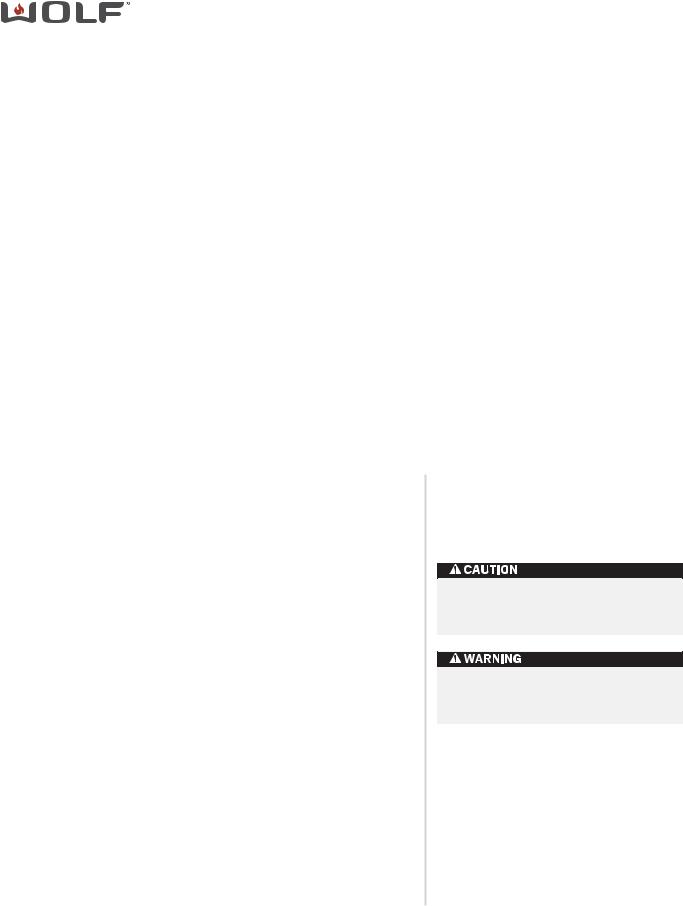
As you read this Use & Care Information, take particular note of the CAUTION and WARNING symbols when they appear.
This information is important for safe and efficient use of the Wolf equipment.
signals a situation where minor injury or product damage may occur if you do not follow instructions.
states a hazard that may cause serious injury or death if precautions are not followed.
In addition, this Use & Care Information may signal an IMPORTANT NOTE which highlights information that is especially important.
WOLF® is a registered trademark of Wolf Appliance, Inc.

W O L F C O N V E C T I O N M I C R OWAV E OV E N
T H A N K YO U |
|
|
|
|
|
|
|
Your purchase of a Wolf convection |
|
|
|
|
|
||
|
|
|
|
|
|||
microwave oven attests to the importance |
|
|
|
|
|
||
|
Read all instructions before using |
|
|||||
you place upon the quality and performance |
|
||||||
of your cooking equipment. We understand |
this appliance to reduce the risk |
|
|||||
this importance and have designed and built |
of burns, electric shock, fire, |
|
|||||
your microwave oven with quality materials |
injury to persons or exposure to |
|
|||||
and workmanship to give you years of |
excessive microwave energy. |
|
|||||
dependable service. |
|
|
|
|
|||
We know you are eager to start cooking, but |
|
|
|
|
|||
before you do, please take some time to read |
PRECAUTIONS |
||||||
this Use & Care Information. Whether you are |
|||||||
a beginning cook or an expert chef, it will be |
TO AVOID |
||||||
to your benefit to familiarize yourself with the |
|||||||
safety practices, features, operation and care |
POSSIBLE EXPOSURE |
||||||
|
|
|
|
||||
recommendations of the Wolf convection |
TO EXCESSIVE |
||||||
microwave oven. |
|||||||
|
|
|
|
||||
We appreciate your choice of a Wolf Appli- |
MICROWAVE ENERGY |
||||||
ance product and welcome any suggestions |
|||||||
or comments you may have. To share your |
Do not attempt to operate this |
||||||
opinions with us, visit www.wolfappliance.com. |
microwave oven with the door open |
||||||
|
|
|
|||||
The symbol |
on the product or on its pack- |
since open-door operation can result |
|||||
aging indicates that this product may not be |
in harmful exposure to microwave |
||||||
treated as household waste. Instead it shall |
energy. It is important not to defeat |
||||||
be handed over to the applicable collection |
or tamper with the safety interlocks. |
||||||
point for the recycling of electrical and elec- |
Do not place any object between the |
||||||
tronic equipment. By ensuring this product is |
|||||||
disposed of correctly, you will help prevent |
microwave oven front face and the |
||||||
potential negative consequences for the envi- |
door or allow soil or cleaner residue |
||||||
ronment and human health, which could |
to accumulate on sealing surfaces. |
||||||
otherwise be caused by inappropriate waste |
Do not operate the microwave oven |
||||||
handling of this product. For more detailed |
|||||||
information about recycling of this product, |
if it is damaged. It is particularly |
||||||
please contact your local city office, your |
important that the oven door close |
||||||
household waste disposal service or the shop |
properly and that there is no damage |
||||||
where you purchased the product. |
to the: door (bent), hinges and |
||||||
|
|
|
latches (broken or loosened) or door |
||||
|
|
|
seals and sealing surfaces. |
||||
The microwave oven should not be adjusted or repaired by anyone except properly qualified service personnel.
C O N T A C T
I N F O R M A T I O N
Website:
wolfappliance.com
5

I M P O RTA N T S A F E T Y I N S T RU C T I O N S A N D P R E C A U T I O N S
R E A D A L L I N S T R U C T I O N S B E F O R E U S I N G T H I S A P P L I A N C E
TO AVOID THE DANGER OF FIRE
The microwave oven should not be left unattended during operation. Power levels that are too high or cooking times that are too long may overheat foods resulting in a fire.
The electrical outlet must be readily accessible so that the unit can be unplugged easily in an emergency.
The AC power supply must be 230-240 V, 50 Hz, with a minimum 16 A distribution line fuse, or a minimum 16 A distribution circuit breaker.
It is recommended that a separate circuit serving only this appliance be provided.
Do not store or use the oven outdoors.
If food being heated begins to smoke, DO NOT OPEN THE DOOR. Turn off and unplug the oven and wait until the food has stopped smoking. Opening the door while food is smoking may cause a fire.
Only use microwave-safe containers and utensils. See page 35.
Do not leave the oven unattended when using disposable plastic, paper or other combustible food containers.
Clean the waveguide cover, the oven cavity and the turntable after use. These must be dry and free from grease. Built-up grease may overheat and begin to smoke or catch fire.
Do not place flammable materials near the oven or ventilation openings. Do not block the ventilation openings.
Remove all metallic seals, wire twists, etc., from food and food packages. Arcing on metallic surfaces may cause a fire.
Do not use the microwave oven to heat oil for deep frying. The temperature cannot be controlled and the oil may catch fire.
To make popcorn, only use special microwave popcorn makers.
Do not store food or any other items inside the oven.
Check the settings after you start the oven to ensure the oven is operating as desired.
6
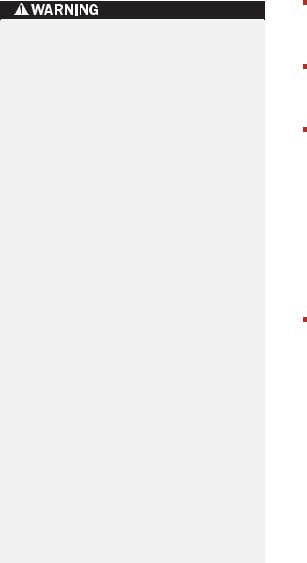
TO AVOID THE POSSIBILITY OF INJURY
Do not operate the oven if it is damaged or malfunctioning. Check the following before use:
a)The door; make sure the door closes properly and ensure it is not misaligned or warped.
b)The hinges and door safety latches; check to make sure they are not broken or loose.
c)The door seals and sealing surfaces; ensure that they have not been damaged.
d)Inside the oven cavity or on the door; make sure there are no dents.
e)The power supply cord and plug; ensure that they are not damaged.
Never adjust, repair or modify the oven yourself. It is hazardous for anyone other than a competent person to carry out any service or repair operation which involves the removal of a cover which gives protection against exposure to microwave energy.
Do not operate the oven with the door open or alter the door safety latches in any way.
Do not operate the oven if there is an object between the door seals and sealing surfaces.
Do not allow grease or dirt to build up on the door seals and adjacent parts. Follow the instructions for “Cleaning and Care” on page 45. Failure to maintain the oven in a clean condition could lead to a deterioration of the surface that could adversely affect the life of the appliance and possibly result in a hazardous situation.
Individuals with PACEMAKERS should check with their doctor or the manufacturer of the pacemaker for precautions regarding microwave ovens.
7

I M P O RTA N T S A F E T Y I N S T RU C T I O N S A N D P R E C A U T I O N S
TO AVOID THE POSSIBILITY
OF ELECTRIC SHOCK
Under no circumstances should you remove the outer cabinet.
Never spill or insert any objects into the door lock openings or ventilation openings. In the event of a spill, turn off and unplug the oven immediately and call an authorised service agent.
Do not immerse the power supply cord or plug in water or any other liquid.
Do not allow the power supply cord to run over any hot or sharp surfaces, such as the hot air vent area at the top rear of the oven.
Do not attempt to replace the oven lamp yourself or allow anyone who is not authorised to do so. If the oven lamp fails, please consult your dealer or an authorised service agent.
If the power supply cord of this appliance is damaged, it must be replaced with a special cord. The exchange must be made by an authorised service agent.
8

TO AVOID THE POSSIBILITY OF EXPLOSION AND SUDDEN BOILING
Liquids and other foods must not be heated in sealed containers since they are liable to explode.
Never use sealed containers. Remove seals and lids before use. Sealed containers can explode due to a build up of pressure even after the oven has been turned off.
Take care when microwaving liquids. Use a wide-mouthed container to allow bubbles to escape.
Microwave heating of beverages can result in delayed eruptive boiling, therefore care has to be taken when handling the container.
To prevent sudden eruption of boiling liquid and possible scalding:
1)Stir liquid prior to heating/reheating.
2)It is advisable to insert a glass rod or similar utensil into the liquid whilst reheating.
3) Let liquid stand for at least 20 seconds in the oven at the end of cooking time to prevent delayed eruptive boiling.
Do not cook eggs in their shells, and whole hard boiled eggs should not be heated in microwave ovens since they may explode even after microwave cooking has ended. To cook or reheat eggs which have not been scrambled or mixed, pierce the yolks and the whites, or the eggs may explode. Shell and slice hard boiled eggs before reheating them in the microwave oven.
Pierce the skin of such foods as potatoes, sausages and fruit before cooking, or they may explode.
9

I M P O RTA N T S A F E T Y I N S T RU C T I O N S A N D P R E C A U T I O N S
TO AVOID THE POSSIBILITY
OF BURNS
Use pot holders or oven gloves when removing food from the oven to prevent burns.
Always open containers, popcorn makers, oven cooking bags, etc., away from the face and hands to avoid steam burns.
To avoid burns, always test food temperature and stir before serving and pay special attention to the temperature of food and drink given to babies, children or the elderly.
Temperature of the container is not a true indication of the temperature of the food or drink; always check the food temperature.
Always stand back from the oven door when opening, to avoid burns from escaping steam and heat.
Slice stuffed baked foods after heating to release steam and avoid burns.
Keep children away from the door to prevent them burning themselves.
Do not touch the oven door, outer cabinet, rear cabinet, oven cavity, ventilation openings, accessories and dishes during GRILL mode,
CONVECTION mode, DUAL mode, AUTO COOK and AUTO COOK FROM FROZEN operation as they will become hot. Before cleaning make sure they are not hot.
10

TO AVOID MISUSE BY CHILDREN
Only allow children to use the oven without supervision when adequate instructions have been given so that the child is able to use the oven in a safe way and understands the hazards of improper use.
This appliance is not intended for use by persons (including children) with reduced physical, sensory or mental capabilities, or lack of experience and knowledge, unless they have been given supervision or instruction concerning use of the appliance by a person responsible for their safety.
Children should be supervised to ensure that they do not play with the appliance.
Do not lean or swing on the oven door. Do not play with the oven or use it as a toy.
Children should be taught all important safety instructions: use of pot holders, careful removal of food coverings; paying special attention to packaging (e.g. self-heating materials) designed to make food crisp, as they may be extra hot.
OTHER WARNINGS
Never modify the oven in any way.
Do not move the oven while it is in operation.
This oven is for home food preparation only and may only be used for cooking food. It is not suitable for commercial or laboratory use.
11

I M P O RTA N T S A F E T Y I N S T RU C T I O N S A N D P R E C A U T I O N S
TO PROMOTE TROUBLE-FREE USE OF YOUR OVEN AND AVOID DAMAGE
Never operate the oven when it is empty except where recommended in the operation manual, see page 27. Doing so may damage the oven.
When using a browning dish or selfheating material, always place a heat-resistant insulator such as a porcelain plate under it to prevent damage to the turntable due to heat stress. The preheating time specified in the dish’s instructions must not be exceeded.
Do not use metal utensils, which reflect microwaves and may cause electrical arcing. Do not put cans in the oven.
Use only the turntable designed for this oven.
Do not place anything on the outer cabinet during operation.
Do not use plastic containers for microwaving if the oven is still hot from using the GRILL mode,
CONVECTION mode, DUAL mode, AUTO COOK and AUTO COOK FROM FROZEN, because they may melt. Plastic containers must not be used during above modes unless the container manufacturer says they are suitable.
NOTE:
If you are unsure how to connect your oven, please consult an authorised, qualified electrician.
Neither the manufacturer nor the dealer can accept any liability for damage to the oven or personal injury resulting from failure to observe the correct electrical connection procedure.
Water vapour or drops may occasionally form on the oven walls or around the door seals and sealing surfaces. This is a normal occurrence and is not an indication of microwave leakage or a malfunction.
SAVE THESE INSTRUCTIONS
12
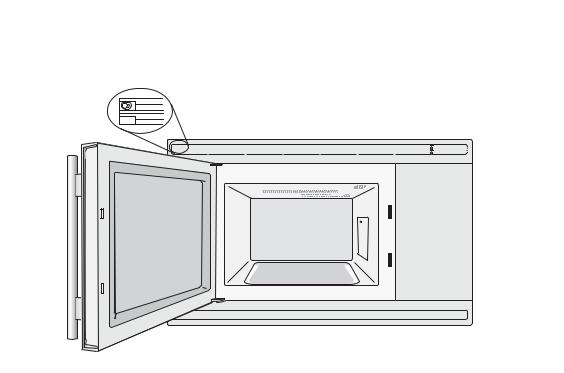
W O L F C O N V E C T I O N M I C R O W A V E F E AT U R E S
M I C R OWAV E OV E N F E A T U R E S |
|
|
|
|
Built-in convection microwave oven with |
|
5 cook settings |
|
|
||
|
40 L capacity |
|
Removable 362 mm turntable and turntable |
|
|
|
|
|
230 V model output power—microwave |
|
support |
|
|||
|
900W, grill 1300W and convection 1450W |
|
Removable low rack for broiling and |
|
|
|
|
|
240 V model output power—microwave |
|
removable high rack for baking |
|
|||
|
900W, grill 1400W and convection 1400W |
|
Oven door with window |
|
Trim allows microwave to be built in to fit |
|
|
|
|
Multiple rack baking |
|
|
|
||
|
above a Wolf built-in oven |
|
|
|
|
|
|
|
Classic stainless steel trim |
|
Safety door latches—oven will not operate |
|
|
||
|
|
unless the door is closed |
|
|
|
||
|
|
|
|
|
5 auto-cook settings |
|
Oven light comes on when oven is |
|
|
||
|
|
|
|
|
Multiple language settings |
|
operating or door is open |
|
|||
|
Energy save mode |
|
Tight door seals |
|
|
||
|
10 convection temperature settings |
|
Rear ventilation openings |
|
|
||
C O N V E C T I O N M I C R O W A V E O V E N W I T H G R I L L
Model ICBMW30-230/ICBMW30-240
Fixing |
Grill heating |
Convection |
Oven |
point |
element |
heating element |
lamp |
Fixing Door opening  point handle
point handle
Control panel
Fixing point
Fixing |
Door seals and |
Coupling |
Waveguide |
Rating |
Oven |
point |
sealing surfaces |
|
cover |
plate |
cavity |
13
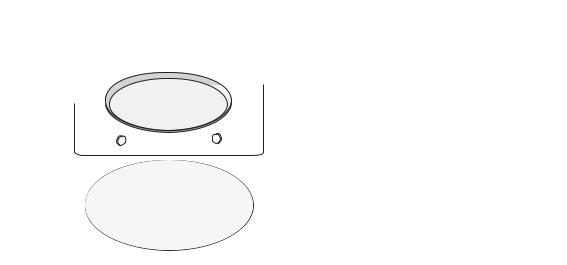
W O L F C O N V E C T I O N M I C R O W A V E F E AT U R E S
M I C R OWAV E OV E N A C C E S S O R I E S |
|
|
||
Check to make sure the accessories shown in |
N O T E S : |
|||
the illustrations below are supplied. |
|
Always operate the oven with the turntable |
||
|
|
Place the turntable support into the |
|
|
|
|
|
||
|
|
|
and support fitted correctly. This promotes |
|
|
|
|||
|
|
coupling in the centre of the oven floor, |
|
thorough even cooking. A badly fitted |
|
|
ensuring you place it TOP side up, (TOP is |
|
turntable may rattle, may not rotate |
|
|
engraved on one side). It should be able to |
|
properly and damage the oven. |
|
|
freely rotate around the coupling. |
|
The turntable rotates clockwise or counter |
|
|
Place the turntable on to the turntable |
|
|
|
|
|
||
|
|
|
clockwise. The rotary direction may change |
|
|
|
|||
|
|
support. |
|
each time you start the oven. This does not |
|
|
Place the high/low racks onto the turntable |
|
affect cooking performance. |
|
|
|
|
|
|
|
if necessary. |
|
When you order accessories, please |
|
|
|
||
|
|
|
|
mention two details: part name and model |
|
|
|
|
name to your dealer or service agent. |
M I C R O W A V E O V E N A C C E S S O R I E S
Turntable |
Turntable |
|
support |
Coupling
|
|
|
|
|
|
|
|
|
|
|
|
|
|
|
Low rack |
High rack |
||||
These racks are used for cooking in Convection, Dual or Grill mode.
14

W O L F C O N V E C T I O N M I C R O W A V E F E AT U R E S
C O N T R O L P A N E L
GRILL indicator
START indicator
COOKING IN
PROGRESS indicator
LESS/MORE buttons
TIMER/WEIGHT knob
Rotate the knob to enter either the cooking/defrost time or weight of food.
AUTO COOK button
TIMER button
CONVECTION button
STOP button
Digital Display
CONVECTION indicator MICROWAVE indicator INFORMATION indicator
INFORMATION button LANGUAGE button
COOKING MODE knob  for microwave cooking
for microwave cooking
 for microwave cooking with GRILL
for microwave cooking with GRILL
 for microwave cooking with CONVECTION
for microwave cooking with CONVECTION
 for GRILL
for GRILL
 for CONVECTION
for CONVECTION
AUTO DEFROST button
COOK FROM FROZEN button
MICROWAVE POWER LEVEL button
 +30 button (START)
+30 button (START)
15

W O L F C O N V E C T I O N M I C R O W A V E I N S TA L L AT I O N
S P E C I F I C AT I O N S |
|
|
|
230 V Model |
240 V Model |
|
|
|
AC Line Voltage |
230 V, 50 Hz, single phase |
240 V, 50 Hz, single phase |
|
|
|
AC Power required: |
|
|
Microwave |
1.5 kW |
1.55 kW |
Grill |
2.8 kW |
2.85 kW |
Grill/Microwave |
2.8 kW |
2.95 kW |
Convection |
2.8 kW |
2.85 kW |
Convection/Microwave |
2.95 kW |
2.95 kW |
|
|
|
Output power: |
|
|
Microwave |
900 W (IEC 60705) |
900 W (IEC 60705) |
Grill heating elements |
1300 W (650 W x 2) |
1400 W (700 W x 2) |
Convection |
1450 W |
1400 W |
|
|
|
|
All Models |
|
|
Distribution line fuse/circuit breaker |
Minimum 16A |
|
|
Microwave Frequency |
2450 MHz * (Group 2/Class B) |
|
|
Outside Dimensions |
759 mm (W) x 460 mm (H) x 537 mm (D) |
|
|
Cavity Dimensions |
375 mm (W) x 272 mm (H) x 395 mm (D) ** |
|
|
Oven Capacity |
40 litres ** |
|
|
Turntable |
ø362 mm, ceramic |
|
|
Weight |
30 kg |
|
|
Oven lamp |
25 W/240–250 V |
*This Product fulfils the requirement of the European standard EN55011. In conformity with this standard, this product is classified as group 2 class B equipment. Group 2 means that the equipment intentionally generates radio-frequency energy in the form of electromagnetic radiation for the heat treatment of food. Class B equipment means that the equipment is suitable to be used in domestic establishments.
**Internal capacity is calculated by measuring maximum width, depth and height. Actual capacity for holding food is less.
This oven complies with the requirements of Directives 2004/108/EC, 2006/95/EC, 2009/125/EC and 2011/65/EU.
SPECIFICATIONS ARE SUBJECT TO CHANGES WITHOUT NOTICE AS
PART OF CONTINUOUS IMPROVEMENT.
16
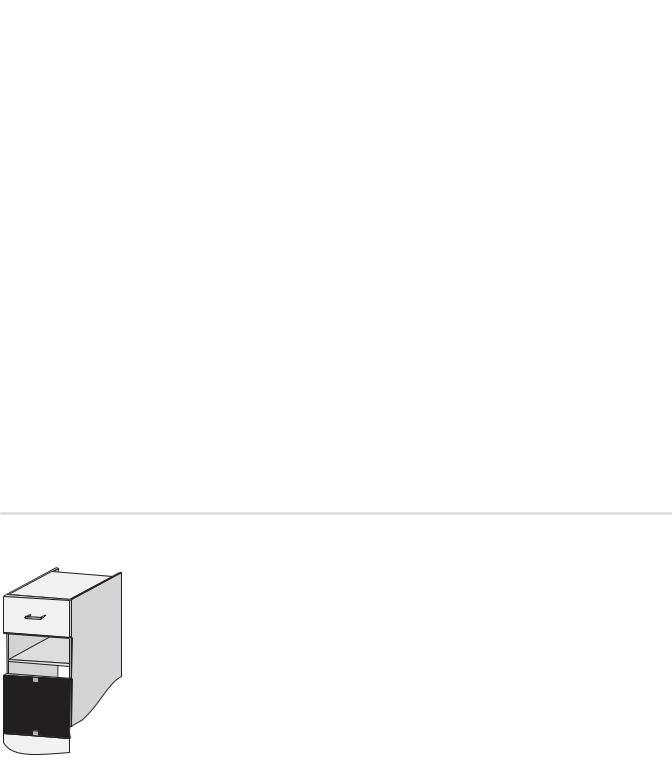
W O L F C O N V E C T I O N M I C R O W A V E I N S TA L L AT I O N
I N S TA L L I N G T H E M I C R O W A V E
1)Remove all packaging and check carefully for any signs of damage.
2)If the microwave is fitted in position C, ensure that the minimum air gaps are maintained as shown in the diagram.
3)Secure four cupboard retention blocks in position using the setting template (TMAPTA004URR0).
4)Fit the appliance into the kitchen cupboard, lift over the bottom/front blocks then push slowly, and without force, until the front frame of the oven seals against the front opening of the cupboard.
5)Ensure the appliance is stable and not leaning.
6)Fix the oven in position with the screws provided. The fixing points are located within the louvre areas at the top and bottom of the oven (see illustration on page 13).
7)Fit the frame fastner caps to the four fixing positions (2 spare caps are provided).
8)It is important to ensure that the installation of this product conforms to the instructions in this operation manual and the conventional oven or hob manufacturer’s installation instructions.
|
min. 20 mm |
|
Position A |
mm |
|
450 |
||
|
||
Conventional |
|
|
oven |
|
min. 20 mm
Position B |
mm |
|
450 |
||
|
5 mm |
65 mm |
|
|
|
mm |
|
Position C |
450 |
|
|
20 mm |
|
Niche Size |
Chimney |
Gap Between |
Position |
W x D x H |
(min) |
Cupboard & Ceiling |
|
|
|
|
A |
730 x 610 x 450 |
20 |
50 |
|
|
|
|
B |
730 x 610 x 450 |
20 |
50 |
|
|
|
|
C |
730 x 610 x 450 |
20 |
Not Applicable |
|
|
|
|
Measurements in millimeters
|
Chimney |
|
|
Cable clip |
Chimney |
|
|
|
Position A |
|
Cable clip |
|
|
Position B |
D
Conventional |
Position C |
oven |
|
The microwave can be fitted in position A, B or C
17
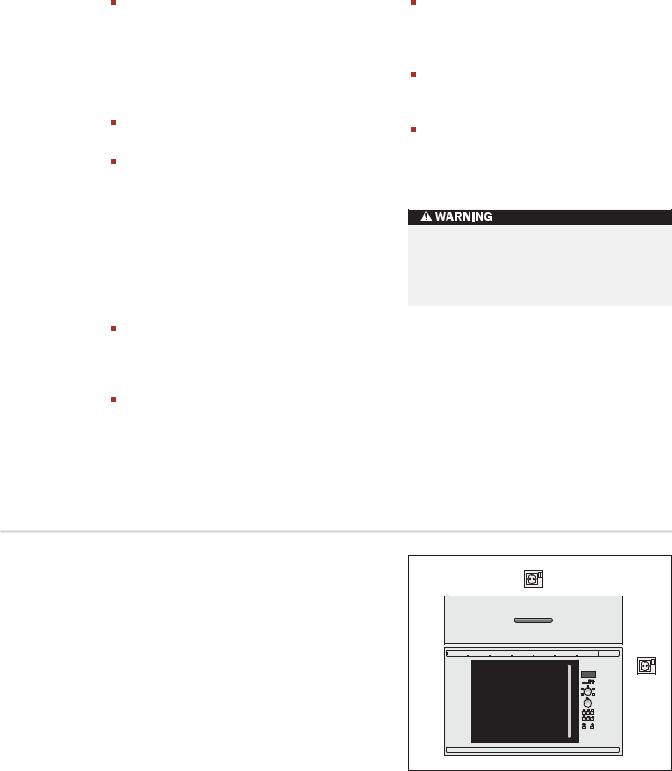
W O L F C O N V E C T I O N M I C R O W A V E I N S TA L L AT I O N
E L E C T R I C A L R E Q U I R E M E N T S
The electrical outlet should be readily accessible so that the unit can be unplugged easily in an emergency. Or it should be possible to isolate the oven from the supply by incorporating a switch in the fixed wiring in accordance with the wiring rules.
The socket should not be positioned behind the cupboard.
The best position is above the cupboard, see (A). If connection is to be made to position (A), remove the clip from position 15 on the rear of the oven (see page 13) and use the clip to secure the power supply cord to the top of the housing unit (see page 17). When not connecting the power supply cord to position (A), the power supply cord should be routed under the oven.
Connect the appliance to a single phase 230-240 V/50 Hz alternating current via a correctly installed earth socket. The socket must be fused with a 16 A fuse.
The power supply cord may only be replaced by an electrician.
Before installing, tie a piece of string to the power supply cord to facilitate connection to point (A) when the appliance is being installed.
When inserting the appliance into the highsided cupboard, DO NOT crush the power supply cord.
Do not immerse the power supply cord or plug in water or any other liquid.
E L E C T R I C A L C O N N E C T I O N S
THIS APPLIANCE MUST BE EARTHED The manufacturer declines any liability should this safety measure not be observed.
If the plug that is fitted to your appliance is not suitable for your socket outlet, you must call your local service agent.
(A)
Electrical outlet
18

W O L F C O N V E C T I O N M I C R O W A V E I N S TA L L AT I O N
E C O L O G I C A L D I S P O S A L
P A C K A G I N G M A T E R I A L S O L D A P P L I A N C E S
Microwave ovens require effective packaging to protect them during transportation. Only the minimum packaging necessary is used.
Packaging materials (e.g. foil or styrofoam) can place children at risk.
Danger of suffocation. Keep packaging material away from children.
All packaging materials used are environment friendly and can be recycled. The cardboard is made from recycled paper and the wooden parts are untreated. Plastic items are marked as follows:
«PE» polyethylene eg packaging film «PS» polystyrene eg packaging (CFC-free) «PP» polypropylene eg packaging straps
By using and re-using the packaging, raw materials are saved and waste volume is reduced.
Packaging should be taken to your nearest recycling centre. Contact your local council for information.
Old appliances should be made safe before disposal by removing the plug, and cutting off and disposing of the power cable. It should then be taken to the nearest recycling centre. Check with your local Council or Environmental Health Office to see if there are facilities in your area for recycling the appliance.
19
W O L F C O N V E C T I O N M I C R O W A V E O P E R AT I O N
W H A T A R E M I C R OWAV E S ? |
|
|
Like radio and television waves, microwaves |
C H A R A C T E R I S T I C S O F M I C R O W A V E S |
|
are electromagnetic waves. |
Microwaves penetrate all non-metal objects |
|
Microwaves are produced by a magnetron |
||
made of glass, china, earthenware, plastic, |
||
inside the microwave oven, and these vibrate |
||
wood or paper. This is why the microwaves |
||
the molecules of water present in the food. |
||
never make these materials hot. Dishes |
||
The friction this causes produces heat, which |
||
become hot only because the food inside them |
||
ensures that the food is defrosted, heated or |
||
is hot. |
||
cooked through. |
||
The food absorbs the microwaves and is |
||
The secret of the reduced cooking times is the |
||
heated. Microwaves cannot pass through |
||
fact that the microwaves penetrate the food |
||
objects made of metal and so they are |
||
from every direction. Energy is used to the full. |
||
deflected. For this reason metal objects are not |
||
In comparison, the energy from a conventional |
||
normally suitable for microwave cookery. |
||
hob passes from the burner through the pan |
||
There are exceptions where you can actually |
||
and so to the food. This method wastes a great |
||
make use of the fact that the microwaves |
||
deal of energy. |
||
cannot pass through metal. If you cover food |
||
|
||
|
with aluminium foil at specific points while it is |
|
|
defrosting or cooking, you can prevent those |
|
|
parts from getting too warm, too hot, or over- |
|
|
cooked. Please check out the advice given in |
|
|
the guide. |
20

W O L F C O N V E C T I O N M I C R O W A V E O P E R AT I O N
W H A T Y O U R M I C R OWAV E C A N D O
M I C R O W A V E O P E R A T I O N C O N V E C T I O N O P E R A T I O N
By using the microwave facility in your new combination microwave oven you can, for example, quickly heat up ready-prepared meals or drinks, or melt butter or chocolate in no time at all.
The microwave oven is equally good at defrosting food. Sometimes, however, it is better to combine the microwave with convection heating or grilling (combined operation). You can then cook the food rapidly and brown it at the same time. Cooking times are generally much shorter than in conventional food preparation.
C O M B I N E D O P E R A T I O N
( M I C R O W A V E O P E R A T I O N W I T H C O N V E C T I O N O R G R I L L )
By combining two modes of operation the benefits of your oven are cleverly linked together.
You are able to choose between
microwave + convection (ideal for joints of meat, poultry, puddings, bread and cakes) and
microwave + grill (ideal for pizzas, snacks, quick fry-ups, joints, poultry, chicken legs, kebabs, Welsh rarebit and cooking au gratin).
Using the combination facility you can cook and brown food at the same time.
The advantage is that the convected heat or the heat from the grill quickly seals the pores in the outer layers of the food. The microwaves ensure a short and gentle cooking period. The juices are preserved inside the food and the outside is crisp.
You can also use convection without microwave. The result is like using a conventional oven. The circulating air quickly heats up the external parts of the food without drying up the meat juices and the foods.
This sealing process means that the meals remain tasty and cook in a shorter time than with conventional ovens with upper and lower heaters.
G R I L L O P E R A T I O N
This appliance comes with a quartz grill above the cooking area. It can be used as a conventional grill without microwave. You can quickly bake or grill dishes. It’s also suitable for steaks, chops and cakes.
21
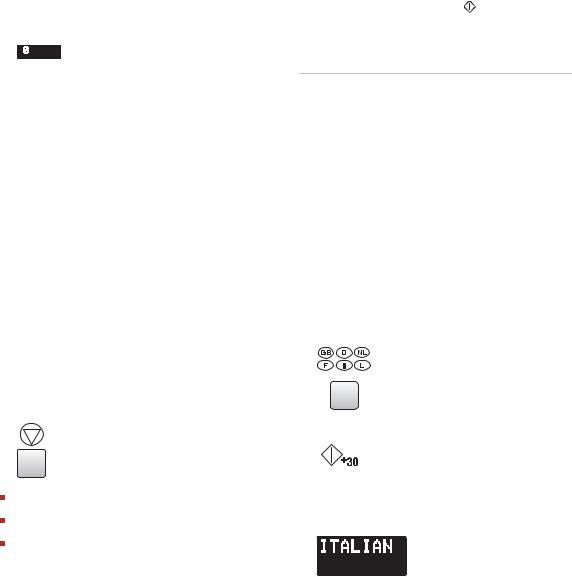
W O L F C O N V E C T I O N M I C R O W A V E O P E R AT I O N
B E F O R E O P E R A T I O N |
S E L E C T I N G T H E L A N G U A G E |
|||
1) |
Plug in the oven. Nothing will appear on |
The oven comes set for English. You can |
||
|
the display at this time. |
change the language. To change, press the |
||
2) |
Open the door. The oven display will show |
LANGUAGE button until the desired language |
||
is displayed. Then press the |
+30 button. |
|||
|
“SELECT LANGUAGE” in 6 languages. |
|||
|
|
|
||
3) |
Close the door. The oven display will show |
Press LANGUAGE |
|
|
|
. |
|
||
|
Button |
LANGUAGE |
||
|
|
|||
NOTE: If you do nothing for 3 minutes, the power will go off automatically. Nothing will appear on the display at this time. To restore power on, open the door.
4) Heat the oven without food (see page 27).
C O O K I N G H I N T S
The oven has an ‘Information Display System’ which offers you step by step instructions to easily guide you through each feature, and enable you to gain information in your desired language. The oven has an INFORMATION button for getting instructions for each button. Indicators will appear in the display, after pressing a button, to inform you of the next operation step.
U S I N G T H E S TO P B U T TO N
Use the STOP button to:
Erase a mistake during programming.
Stop the oven temporarily during cooking.
Cancel a programme during cooking, press the STOP button twice.
once |
ENGLISH |
|
|
twice |
DEUTSCH |
|
|
3 times |
NEDERLANDS |
|
|
4 times |
FRANÇAIS |
|
|
5 times |
ITALIAN |
|
|
6 times |
ESPAÑOL |
|
|
E X A M P L E |
|
To select Italian: |
|
1)Choose the desired language by pressing the LANGUAGE button.
x5
2)Press the  +30 button to start the setting.
+30 button to start the setting.
 x1
x1
3)Check the display.
NOTE:
The selected language will be memorised even if the electical power supply is interrupted.
22

W O L F C O N V E C T I O N M I C R O W A V E O P E R AT I O N
NOTES
23

W O L F C O N V E C T I O N M I C R O W A V E O P E R AT I O N
M I C R O W A V E P OW E R L E V E L S |
|
|
|
Your oven has 5 power levels. To choose the |
T O S E T T H E |
P O W E R L E V E L |
|
power level for cooking, follow the advice |
1) Rotate the COOKING MODE dial to the |
||
given in the recipe section. Generally the |
|||
microwave setting. |
|||
following recommendations apply: |
|||
|
|
||
900 W used for fast cooking or reheating e.g. |
2) Rotate the TIMER/WEIGHT knob clockwise |
||
or counter-clockwise to select cooking time. |
|||
soup, casseroles, canned food, hot beverages, |
|||
|
|
||
vegetables, fish, etc. |
3) Press the MICROWAVE POWER LEVEL |
||
630 W used for longer cooking of dense foods |
button until the desired power level |
||
appears on the display. (If the MICROWAVE |
|||
such as roast joints, meat loaf and plated |
|||
POWER LEVEL button is touched once, |
|||
meals, also for sensitive dishes such as cheese |
|||
will be displayed. If you miss your |
|||
sauce and sponge cakes. At this reduced |
|||
desired level, continue pressing the |
|||
setting, the sauce will not boil over and food |
|||
MICROWAVE POWER LEVEL button until |
|||
will cook evenly without over cooking at the |
|||
you reach the level again). |
|||
sides. |
|||
|
|
||
450 W for dense foods which require a long |
4) Press the |
+30 button. |
|
|
|
||
cooking time when cooked conventionally, eg. |
|
|
|
beef dishes, it is advisable to use this power |
NOTE: |
|
|
setting to ensure the meat will be tender. |
If the power level is not selected, 900 W is |
||
|
|||
270 W (Defrost setting) to defrost, select this |
automatically set. |
||
power setting, to ensure that the dish defrosts |
|
|
|
evenly. This setting is also ideal for simmering |
|
|
|
rice, pasta, dumplings and cooking egg |
|
|
|
custard. |
|
|
|
90 W for gentle defrosting, eg. cream gateaux or pastry.
W = WATT
24
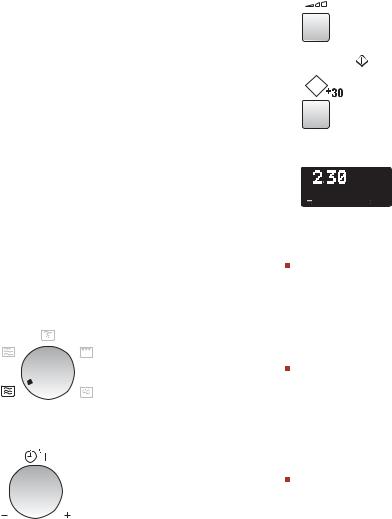
W O L F C O N V E C T I O N M I C R O W A V E O P E R AT I O N
M I C R OWAV E C O O K I N G |
|
|
||
Your oven can be programmed for up to 90 |
3) Press the MICROWAVE POWER LEVEL |
|||
minutes (90.00). The input unit of cooking |
button twice for 630 W microwave power. |
|||
(defrosting) time varies from 10 seconds to |
|
|
||
five minutes. It depends on the total length of |
|
|
||
the cooking (defrosting) time as shown on the |
|
x2 |
||
table opposite: |
|
|
||
|
|
|
||
|
|
4) Press the +30 button once to start cooking. |
||
Cooking Time: |
Increasing unit: |
|
|
|
|
|
|||
|
|
|
|
|
0–5 minutes |
10 seconds |
|
x1 |
|
|
|
|
||
5–10 minutes |
30 seconds |
|
||
5) Check the display. |
||||
|
|
|||
10–30 minutes |
1 minute |
|||
|
|
|||
|
|
|
|
|
30–90 minutes |
5 minutes |
|
|
|
|
|
|
|
|
E X A M P L E
To heat soup for 2 minutes and 30 seconds on 630 W microwave power.
1)Rotate the COOKING MODE dial to the  microwave setting.
microwave setting.
2)Enter desired cooking time by rotating the TIMER/WEIGHT knob clockwise.
NOTES:
When the door is opened during the cooking process, the cooking time on the digital display stops automatically. The cooking time starts to count down again when the door is closed and the  +30 button is pressed.
+30 button is pressed.
If you wish to know the power level during cooking, press the MICROWAVE POWER LEVEL button. As long as your finger is pressing the MICROWAVE POWER LEVEL button, the power level will be displayed.
You can rotate the TIMER/WEIGHT knob clockwise or counter-clockwise. If you rotate the dial counter-clockwise, the cooking time will decrease from 90 minutes by degrees.
25
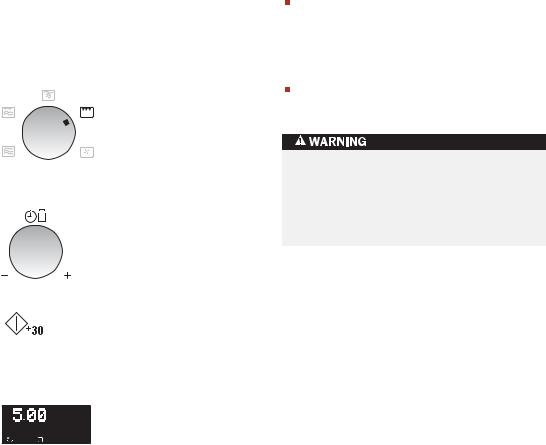
W O L F C O N V E C T I O N M I C R O W A V E O P E R AT I O N
G R I L L C O O K I N G |
|
|
|
The grill heating element at the top of the oven |
NOTES: |
||
cavity has one power setting only. |
|
|
The high or low racks are recommended |
|
|
|
|
|
|
|
when grilling. |
E X A M P L E
To cook cheese on toast for 5 minutes (place toast on the high rack).
1)Rotate the COOKING MODE dial to the  Grill setting.
Grill setting.
2)Enter the desired cooking time by rotating the TIMER/WEIGHT knob clockwise.
You may detect smoke or a burning smell when using the grill for the first time, this is normal and not a sign that the oven is out of order. (Please see heating without food below.)
After cooking the display may show ‘NOW COOLING’.
The oven cavity, door, outer cabinet, turntable, racks and dishes will become very hot, always use thick oven gloves when removing the food or turntable from the oven to prevent burns.
3)Press the  +30 button to start cooking.
+30 button to start cooking.
 x1
x1
4)Check the display.
26
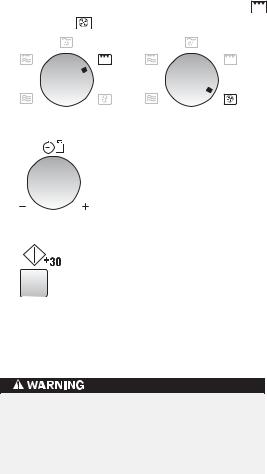
W O L F C O N V E C T I O N M I C R O W A V E O P E R AT I O N
H E A T I N G W I T H O U T F O O D |
|
|
|
|
You may detect smoke or a burning smell |
E X A M P L E |
|
||
when using the grill and convection for the |
1) Rotate the COOKING MODE dial to the |
|||
first time. This is normal and not a sign that |
||||
GRILL or |
CONVECTION setting. |
|||
the oven is out of order. |
||||
|
|
|
||
To avoid this problem, when first using the |
|
|
|
|
oven, heat the oven without food for 20 |
|
|
|
|
minutes on grill and then at convection 250 ˚C. |
|
|
|
|
IMPORTANT NOTE: During operation, to |
|
|
|
|
allow smoke or smells to disperse open a |
2) Enter the required heating time (20 min). |
|||
window or switch the kitchen ventilation on. |
|
|
|
|
|
|
|
||
Make sure there is no food in the oven. |
|
|
|
|
3) Start cooking by pressing the  +30 button.
+30 button.
x1
The oven will count down. When the oven has finished cooking, open the door to cool the oven cavity.
The oven door, outer cabinet & oven cavity will become hot. Take care to avoid burns when cooling the oven down after operation.
27
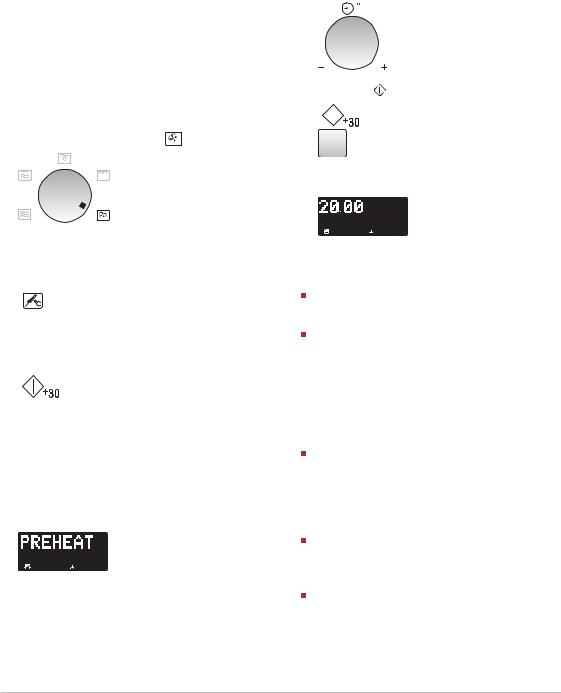
W O L F C O N V E C T I O N M I C R O W A V E O P E R AT I O N
C O N V E C T I O N C O O K I N G |
|
|
|
|
Your oven can be used as a conventional oven |
4) Use the TIMER/WEIGHT knob to input the |
|||
using the convection facility and 10 pre-set |
cooking time (20 min). |
|||
oven temperatures. Refer to the chart below. |
|
|
|
|
|
|
|
||
E X A M P L E 1 |
|
|
|
|
T O C O O K W I T H P R E H E A T I N G |
|
|
|
|
To pre-heat to 180 ˚C and cook for 20 minutes |
5) Press the +30 button. |
|||
at 180 ˚C. |
||||
|
|
|
||
1) Select the cooking mode by rotating the |
|
|
|
|
|
|
|
||
COOKING MODE dial to . |
|
|
x1 |
|
|
|
|
||
2)Enter the desired preheat temperature by pressing the CONVECTION button six times. The display will show 180 ˚C.
 x6
x6
3)Press the  +30 button to start pre-heating.
+30 button to start pre-heating.
 x1
x1
When the pre-heated temperature has been reached the audible signal sounds, the display will show 180 ˚C, open the door and place the food inside the oven. Close the door.
6) Check the display.
NOTES:
When the oven is preheating, the turntable should be in the oven.
After preheating, if you want to cook at a different temperature press the CONVECTION button until the desired setting appears on the display. In the
example above, to change the temperature you would press the CONVECTION button after entering the cooking time.
When the oven reaches the programmed preheating temperature, it will automatically hold at the pre-heated temperature for 30 minutes. After 30 minutes the display may show  or “NOW COOLING”.
or “NOW COOLING”.
After cooking the oven will automatically cool and the display may show “NOW COOLING”.
To get the best results when following pack instructions for convection, please follow the instructions for “conventional oven”.
C O N V E C T I O N S E T T I N G S
Press CONVECTION Button |
1 |
2 |
3 |
4 |
5 |
6 |
7 |
8 |
9 |
10 |
|
|
|
|
|
|
|
|
|
|
|
Oven Temperature (˚C) |
250 |
230 |
220 |
200 |
190 |
180 |
160 |
130 |
100 |
40 |
|
|
|
|
|
|
|
|
|
|
|
28
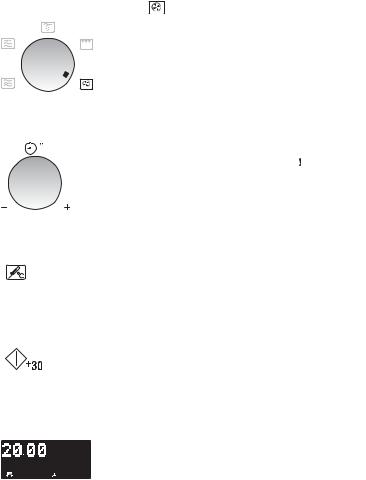
W O L F C O N V E C T I O N M I C R O W A V E O P E R AT I O N
C O N V E C T I O N C O O K I N G |
|
|
|
|
||
E X A M P L E 2 |
NOTES: |
|||||
T O C O O K W I T H O U T P R E H E A T I N G |
After cooking the oven will automatically |
|||||
|
|
|||||
To cook at 250 ˚C for 20 minutes. |
cool and the display may show “NOW |
|||||
1) Select the cooking mode by rotating the |
COOLING”. |
|||||
To change the convection temperature, |
||||||
COOKING MODE dial to . |
||||||
|
|
press the CONVECTION button until the |
||||
|
|
desired temperature appears on the display. |
||||
|
|
You may detect smoke or a burning smell |
||||
|
|
|||||
|
|
when using convection for the first time. |
||||
|
|
This is normal and is not a sign that the |
||||
2) Use the TIMER/WEIGHT knob to input the |
oven is out of order. (Please see “Heating |
|||||
cooking time (20 min). |
Without Food” on page 27.) |
|||||
|
|
|
|
|
|
|
|
|
|
|
|
|
|
|
|
|
|
|
||
|
|
|
|
|
|
|
|
|
The oven cavity, door, outer cabinet, |
|
|||
|
|
turntable, racks and dishes will become |
|
|||
|
|
very hot, always use thick oven gloves |
|
|||
3) Select the desired cooking temperature. |
when removing the food or turntable |
|
||||
(250 ˚C). |
from the oven to prevent burns. |
|
||||
|
|
|
|
|
|
|
 x1
x1
4)Press the  +30 button.
+30 button.
 x1
x1
5)Check the display.
29
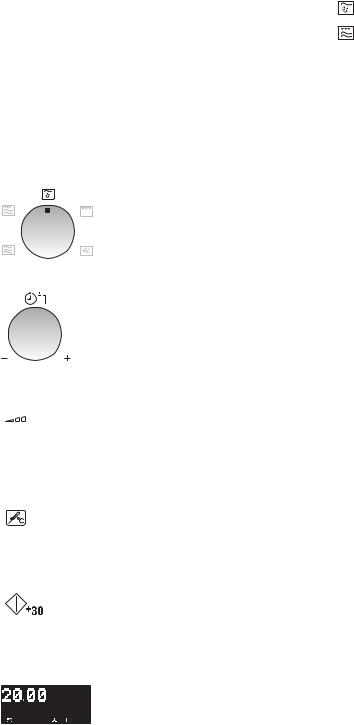
W O L F C O N V E C T I O N M I C R O W A V E O P E R AT I O N
D U A L C O O K I N G |
|
|
|
|
Your oven has 2 DUAL cooking modes |
|
|
Initial |
|
combining 1) Convection & microwave, 2) Grill |
COOKING |
Cooking |
Microwave |
|
with microwave. |
MODE |
Method |
Power |
|
To select the DUAL cooking mode rotate the |
|
|
|
|
DUAL 1 |
Convection 250 ˚C |
270 W |
||
COOKING MODE dial to the desired setting, |
|
|
|
|
DUAL 2 |
Grill |
270 W |
||
then choose the cooking time. Generally, dual |
||||
|
|
|
||
cooking time shortens the total cooking time. |
|
|
|
|
|
NOTES: |
|
|
E X A M P L E 1
To cook for 20 minutes on DUAL 1 using 90 W microwave power and 200 ˚C convection.
1)Select the cooking mode by rotating the
COOKING MODE dial to  .
.
The power settings are variable:
DUAL 1  : The oven temperature can be changed from 40 ˚C to 250 ˚C in ten levels. Microwave power levels can be changed from 90 W–630 W in four levels.
: The oven temperature can be changed from 40 ˚C to 250 ˚C in ten levels. Microwave power levels can be changed from 90 W–630 W in four levels.
DUAL 2  : Microwave power levels can be changed from 90 W–900 W in five levels.
: Microwave power levels can be changed from 90 W–900 W in five levels.
2) Enter the desired cooking time (20 min).
3)Press the MICROWAVE POWER LEVEL button twice (90 W).
 x2
x2
4)Press CONVECTION button four times (200 ˚C).
 x4
x4
5)Press the  +30 button.
+30 button.
 x1
x1
6)Check the display.
30
